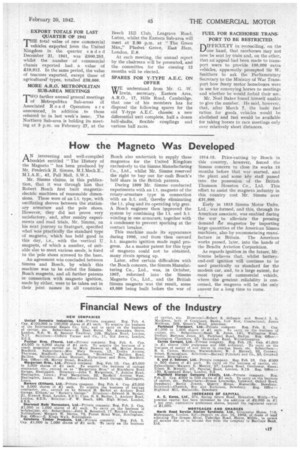How the Magneto Was Developed
Page 19

If you've noticed an error in this article please click here to report it so we can fix it.
AN interesting and well-compiled booklet entitled "The History of the Magneto" has been produced by Mr. Frederick R, Simms, M.I.Mech.E., M:I.A.E„ 42, Pall Mall, SAVA.
Mr. Simms claims, in this publication, that it was through him that Robert Bosch first built magnetic; electric machines of reasonable dimensions. These were of an 1.t. type, with oscillating sleeves between the stationary armature and the pole shoes. However, they did not prove very satisfactory, and, after sundry experiments and road trials, Mr. Simms, on his next journey to Stuttgart, specified what was practically the standard type of magneto, which has held good to this day, i.e., with the vertical U magnets, of which a number, of suitable size to meet various needs, is fiked to the 'pole shoes screwed to the base.
An agreement was concluded between Simms and Bosch, by which this machine was to be called the SimmsBosch magneto, and all further patents in. connection with magneto ignition, made by either, were to be taken out in their joint names in all countries.
Bosch also undertook to supply these magnetos for the United Kingdom exclusively to the Simms Manufacturing Co., Ltd., whilst Mr. Simms reserved the right to buy out for cash Bosch's half share in the British patents.
During 1899 Mr. Simms conducted experiments with an 1.t, magneto of the rotary-armature type in connection with an h.t. coil, thereby eliminating the 1.t. plug and its operating trip gear. A Bosch engineer then improved the system by combining the 1.t. and h.t. winding in one armature, together with a condenser to prevent sparking at the contact breaker.
This machine made its appearance during 1900, and from then onward h.t. magneto ignition made rapid progress. As a master patent for this type of magneto could not be obtained, many rivals sprang up.
Later, after certain difficulties with the Bosch concern, the Simms Manufacturing Co., ;Ad., was, in October, 1907, reformed into the Simms Magneto Co., Ltd., and the British Simms magneto was the result, some 43,000 being built before the war of 1914-18. Pricecutting by Bosch in this country, however, forced the Simms concern to close its works 18 months before that war started, and the plant and some kAy staff passed into the possession of the British Thomson Houston Co., Ltd. This effort to assist the magneto industry in this country cost Mr. Simms over £31,000.
Early in 1913 Simms Motor Units, Ltd., was formed, and this, through its American associate, was enabled during the war to alleviate the pressing demand Par magnetos by importing large quantities of the American Simn2s machines, also by recommencing 'nandfacture in Britain. The American works passed, later, into the hands of the Bendix Aviation Corporation.
As regards ignition in the future, Mr. Simms believes that, Whilst batteryand-coil ignition will continue to be used practically as standard for the modern car, and, to a large extent, for most types of commercial vehicle, where the greatest reliability is concerned, the magneto will be the only answer for a long time to come.




















































